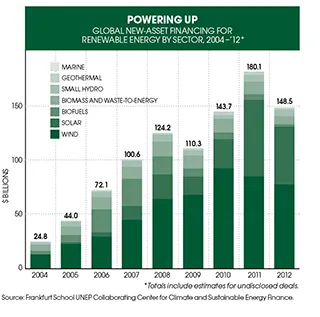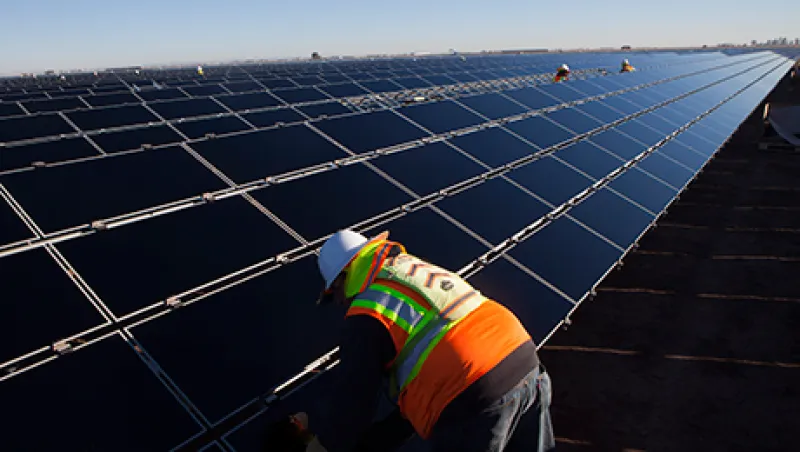The U.S. Solar energy sector is rebounding after a string of bankruptcies, none more visible than the 2011 collapse of Solyndra. After the Fremont, California–based solar panel maker took a $535 million federal loan backed by the Department of Energy, its flameout sparked a backlash against the industry.
Solar’s promise is finally being realized, partly thanks to the DoE loan program that supported Solyndra. Another incentive: 37 states require or encourage utilities to derive some power from renewables projects. Also pitching in are bond investors eager to marry long-term liabilities with the projected life of solar photovoltaic plants — at 25 years, on average, somewhat longer than that of wind farms.
In June, Des Moines, Iowa–based MidAmerican Energy Holdings Co. led a $1 billion bond financing for two projects that will generate an estimated 579 megawatts annually. It was the third quasi-public solar bond issue in 17 months by MidAmerican, a division of Warren Buffett’s Berkshire Hathaway, for Solar Star and Topaz Solar Farm, both located in California. In April, Con Edison Development, owned by U.S. energy giant Consolidated Edison, closed on a $220 million private placement for two California PV projects that will produce a combined 150 megawatts.
“The family of players that do bonds are looking at renewables for the long term, so the potential for follow-on deals exists,” says Mark Noyes, who oversees Con Edison’s portfolio of renewables projects from Valhalla, New York. Developers have been busy. Last year utility-grade solar installations in the U.S. totaled 1,781 megawatts, compared with just nine megawatts in 2007, according to Boston’s GTM Research and Washington-based lobby group Solar Energy Industries Association.

The bond and private placement markets offer terms of more than 25 years for solar plants with utilities contracts in hand, versus at least 20 years for wind farms. Experienced in financing wind and natural-gas projects, both markets include a growing number of clean-energy investors as well as insurance companies and pension funds. (Read more: Governments Launch Green Banks to Boost Private Clean-Tech Investment)
Also, bond pricing is increasingly competitive against commercial bank debt. “Pricing in the bond market has come down as investors allocate more money to structured project finance paper in their quest for yield,” notes Stuart Murray, a New York–based director at Citigroup, which advised on the Con Edison issue and helped underwrite the MidAmerican bonds. Rated BBB– by Fitch Ratings, MidAmerican’s Solar Star notes have a 5.375 percent coupon.
The first U.S. solar bonds of consequence emerged from the now-defunct DoE loan program, which propelled several renewables projects to financial close, broadened the investor base and showed that solar underwritings could be sizable. After the 550-megawatt Topaz project in San Luis Obispo failed to secure a loan, MidAmerican bought it in December 2011 and soon launched a $700 million investment-grade bond issue. The sponsor found a stable of investors who agreed to absorb some of the risk of construction.
Investor enthusiasm prompted MidAmerican to boost the offering to $850 million at close in February 2012. This issue established a template for financing large solar that includes construction risk: Utilities’ development arms buy projects that have yet to break ground from cash-strapped manufacturers. Besides injecting substantial equity, they tap their parent companies’ financial might to help capture lucrative federal tax credits. “Big sponsors with tax appetite make doing these bonds easier,” says Christopher Yonan, a director at Barclays in New York who helped underwrite the Topaz and Solar Star issues.
Operationally, solar is simple for investors to understand, notes Yvette Dennis, a New York–based director at Fitch. Also, solar plants have been better than wind projects at meeting output goals, says Ric Abel, who heads Prudential Capital’s energy finance group in Dallas. Prudential recently led unrated private placements in several combined bank-bond deals that support solar and wind plants. “The conversations that we’re having focus on new deals, not refinancings,” Abel says of PV projects. • •
Read more about banking and capital markets.






